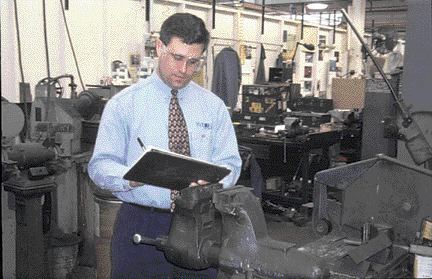
Gripping Advice
Thousands of injuries are attributable to work accidents each year. Make sure your use of tools -- and clamps in particular -- is safe by heeding the advice here.Regularly inspect vises for hairline f...
June 1, 2003 | By MRO Magazine
 Photo: Wilton Corp.A safety inspection of all of a plant's clamping devices works best if the condition is logged in a notebook. Unsafe tools should be tagged for repair or replacement.
Photo: Wilton Corp.A safety inspection of all of a plant's clamping devices works best if the condition is logged in a notebook. Unsafe tools should be tagged for repair or replacement. Thousands of injuries are attributable to work accidents each year. Make sure your use of tools — and clamps in particular — is safe by heeding the advice here.
Regularly inspect vises for hairline fractures and replace them if needed.
Repair vises and clamps where possible. Get rid of damaged or unusable clamping tools.
Don’t use clamps with bent, twisted or cracked frames, badly worn threads on the spindle, bent or cracked spindles, or worn or missing spindle pads.
Spindle slippage and jaw wobble are unsafe and should be taken care of with routine maintenance.
Use the right size clamp for the job at hand. Large clamps on small work throws an abnormal bending strain onto the clamp, screw and frame.
Use C clamps having as small a depth of throat, or reach, as your work will permit.
Fasten vises to the work surface using the proper size nuts, bolts and lockwashers in all mounting positions.
Don’t use a clamp as a permanent holding device, or as a holding device on a moving vehicle.
Avoid using cheater bars as a tightening method on the spindle handle of a vise.
Don’t use a vise to press an object into or out of another object.
Be sure to use proper eye and face protection when using power tools on clamped objects.
The foregoing tips have been compiled from material from Wilton Corp.’s Clamping Campus program.
The impact of clamping on productivity in the workplace is generally underestimated and often ignored, says Hugh McKeown, general sales manager for the James Morton Group of Companies in Cambridge, Ont.
He points to the invention of the all-steel sliding-arm clamp by a German manufacturer, Bessey, which increases the speed of applying a clamp by 900 per cent. The figure was determined when James Morton Ltd., the company’s North American distributor, approached the engineering school of a major Canadian university to evaluate and compare the speed of its sliding-arm clamp with a conventional C clamp.
“There are other factors that add to the productivity gains of the sliding-arm clamp,” says McKeown. The profiled rail offers high strength without the weight and bulk of drop-forged C clamps of the same throat depth and clamp opening. The result is less worker fatigue. It also requires less overall space when applied.
The Acme threaded screw in Bessey clamps is roll-formed, heat-treated, tempered and quenched, making it resist weld spatter and eliminating the need for a copper coating.
With the sliding-arm clamp, the arm can be positioned directly at the best point for maximum pressure and need not be over-extended. With C clamps, the more of the screw that is extended while clamping, the greater the risk is of bending or breaking the clamp. Finally, a single sliding clamp can replace a number of different sizes of C clamps.MRO
For more information on clamps and vises, use the reader reply card number below.
